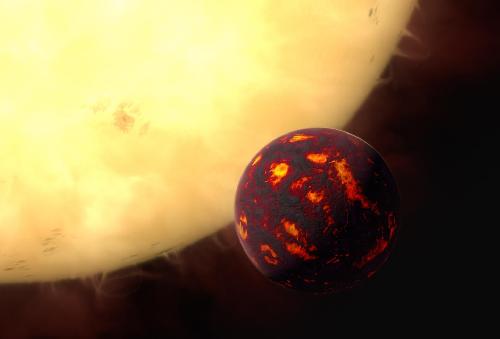The first successful detection of gases in the atmosphere of a super-Earth reveals the presence of hydrogen and helium, but no water vapour, according to UCL researchers. The exotic exoplanet, 55 Cancri e, is over eight times the mass of Earth and has previously been dubbed the 'diamond planet' because models based on its mass and radius have led some astronomers to speculate that its interior is carbon-rich.
Using new processing techniques on data from the NASA/ESA Hubble Space Telescope, a UCL-led team of European researchers has been able to examine the atmosphere of 55 Cancri e in unprecedented detail. The results will be published in the Astrophysical Journal.
"This is a very exciting result because it's the first time that we have been able to find the spectral fingerprints that show the gases present in the atmosphere of a super-Earth," said Angelos Tsiaras, a PhD student at UCL who developed the analysis technique along with colleagues Dr Ingo Waldmann and Marco Rocchetto in UCL Physics & Astronomy.
 This is an artist's impression of 55 Cancri e from further away. Credit: NASA/ESA Hubble Space Telescope
This is an artist's impression of 55 Cancri e from further away. Credit: NASA/ESA Hubble Space Telescope
"Our analysis of 55 Cancri e's atmosphere suggests that the planet has managed to cling on to a significant amount of hydrogen and helium from the nebula from which it formed."
Super-Earths are thought to be the most common planetary type in our galaxy and are so-called because they have a mass larger than Earth but are still much smaller than the gas giants in the Solar System. The Wide Field Camera 3 (WFC3) on Hubble has already been used to probe the atmosphere of two super-Earths, but no spectral features were found in these previous studies.
55 Cancri e has a year that lasts 18 hours and temperatures on the surface are thought to reach around 2000 degrees Celsius. The planet is located in a solar system around 55 Cancri, a star in the Cancer constellation that is around 40 light-years from Earth. Because 55 Cancri is such a bright star, the team were able to use new analysis techniques to extract information about its planetary companion.
Observations were made by scanning WFC3 very quickly across the star to create a number of spectra. By combining these observations and processing through computer analytic 'pipeline' software, the researchers were able to retrieve the spectral fingerprints of 55 Cancri e embedded in the starlight.
"This result gives a first insight into the atmosphere of a super-Earth. We now have clues as to what the planet is currently like, how it might have formed and evolved, and this has important implications for 55 Cancri e and other super-Earths," said Professor Giovanna Tinetti (UCL Physics & Astronomy).
Intriguingly, the data also hinted at a signature for hydrogen cyanide, a marker for carbon-rich atmospheres.
"Such an amount of hydrogen cyanide would indicate an atmosphere with a very high ratio of carbon to oxygen," said Dr Olivia Venot, KU Leuven, Belgium, who developed an atmospheric chemical model of 55 Cancri e that supported the analysis of the observations.
"If the presence of hydrogen cyanide and other molecules is confirmed in a few years' time by the next generation of infrared telescopes, it would support the theory that this planet is indeed carbon rich and a very exotic place," said Professor Jonathan Tennyson (UCL Physics & Astronomy). "Although, hydrogen cyanide or prussic acid is highly poisonous, so it is perhaps not a planet I would like to live on!"
source: University College London